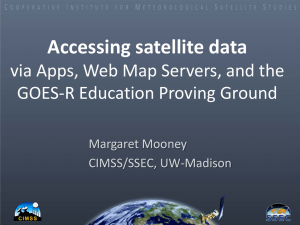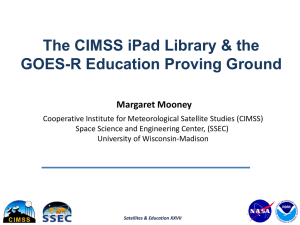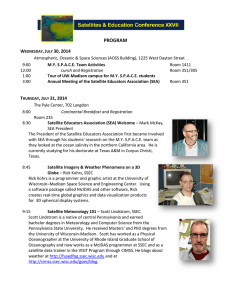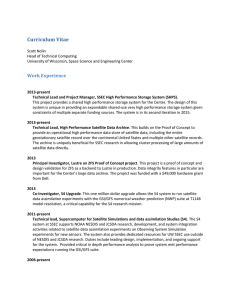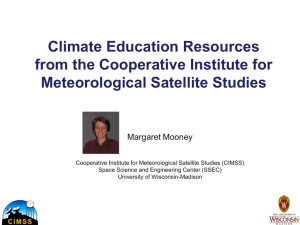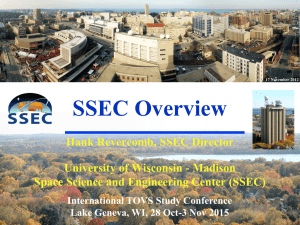Welcome from SSEC
advertisement
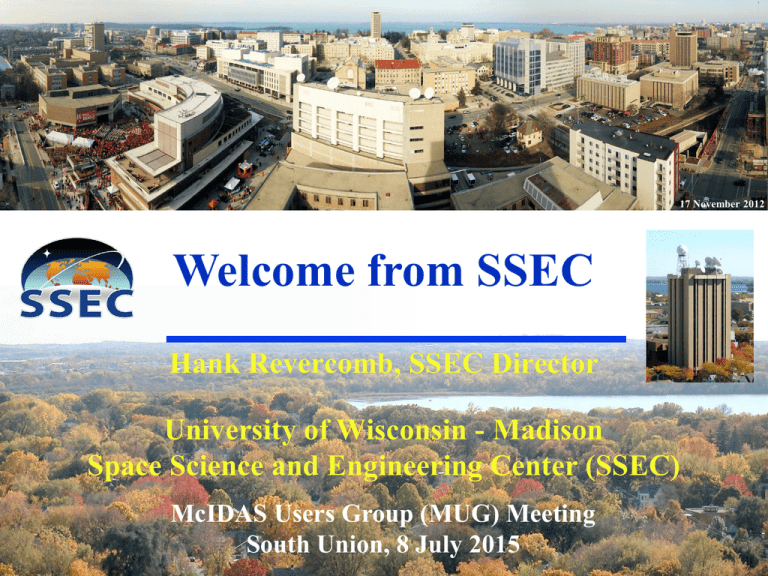
17 November 2012 Welcome from SSEC Hank Revercomb, SSEC Director University of Wisconsin - Madison Space Science and Engineering Center (SSEC) McIDAS Users Group (MUG) Meeting South Union, 8 July 2015 Space Science and Engineering Center UW-Madison Research Center Mission: To conduct atmospheric, oceanic, environmental, and astronomical research using space or space-age techniques to discover and apply the physical properties of our universe for the benefit of humanity From Idea, to Concept, to Implementation, to Information about the world Symbiotic relationship with Department of Atmospheric & Oceanic Sciences symbolized by shared building provided by NSF, NASA, & the State 2 SSEC works to maintain the spirit of exploration of its founder, Verner E. Suomi (1915-1995) with cofounder, Bob Parent (L) 1959: 1st Meteorological Satellite Experiment Earth Radiation Balance Observations on Explorer VII 1966: 1st Earth Imaging from GEO Spin-scan Camera on 1st Advanced Technology Satellite 1980: 1st Infrared Sounder from GEO VISSR Atmospheric Sounder on GOES-4 “Father of Satellite Meteorology” 3 McIDAS (Man-computer Interactive Data Access System) Initially developed to derive winds from cloud tracking; inspiration for earliest digital TV weather forecasts McIDAS going strong at over 40 100’s of National and International users, including international weather services, aviation weather providers, researchers, NOAA Storm Prediction Center… New McIDAS-V version 1.0 for dealing with newer IR hyperspectral data and distributed data/computer resources has become heavily used 4 Weather Satellite renamed “Suomi NPP” On 25 January 2012 NASA & NOAA renamed their newest Earth-observing satellite after UW-Madison space pioneer Blue Marble NPP VIIRS Image, GSFC 5 Weather Satellite renamed “Suomi NPP” On 25 January 2012 NASA & NOAA renamed their newest Earth-observing satellite after UW-Madison space pioneer And SSEC provided the 1st Light Products for the 2 Main Instruments! & Phase A CrIS Sounder Design in 1991 6 Nature of the Organization (1) Space Science & Engineering Center Matrix Organization: PIs are the Cornerstone (30) Staff / Budget: 250-300 staff members A diverse Center: support distributed among agencies, including NASA, NOAA, NSF, DoD, DoE Director is a scientist supported by 3 Executive Directors Executive Director for Administration: Jenny Hackel With part time support from John Roberts, recently retired as Executive Director since 2000, and SSEC Administration since 1975 Executive Director for Science: Wayne Feltz Also an active project leader and CIMSS Executive Director Executive Director for Technology: Fred Best Also an active project leader and supported by Associate Director Mark Mulligan 7 Nature of the Organization (2) Space Science & Engineering Center SSEC includes a major institute & long-term projects Cooperative Institute for Meteorological Satellite Studies (CIMSS): SSEC includes a cooperative institute with NOAA and NASA established 1980, Professor Steve Ackerman, Director (Verner Suomi, founder) Antarctic Meteorological Research Center (AMRC): Providing Automated Weather Stations since 1980, Matthew Lazzara, Director (Professor Charles Stearns, founder) US Ice Drilling Design & Operations (IDDO): Providing NSF-sponsored researchers with ice coring & drilling capabilities in polar and high- altitude sites; Kristina Slawny, Director; Mark Mulligan, PI (Professor Charles Bentley, founder) Office of Space Science Education (OSSE): K-12 programs, public outreach, internships; Rosalyn Pertzborn, Director (Dr. Sanjay Limaye, founder) 8 Ratio Cooperative Institute for Meteorological Satellite Studies (CIMSS) 7 6 5 4 3 2 1 0 A. 24-HR Temperature Ratio (NOSAT/NORAOB) Ratio DEC APR Season JUL B. 24-HR u-Component Ratio (NOSAT/NORAOB) 7 6 5 4 3 2 1 0 DEC APR Season JUL Ratio C. 24-HR Rel. Humidity Ratio (NOSAT/NORAOB) 7 6 5 4 3 2 1 0 DEC 300 hPa APR Season 500 hPa 700 hPa JUL 850 hPa 1000 hP 9 Cooperative Institute for Meteorological Satellite Studies (CIMSS) Ratio SSEC/CIMSS Legacy for over 90% of current GOES Operational Products 7 6 5 4 3 2 1 0 A. 24-HR Temperature Ratio (NOSAT/NORAOB) Ratio DEC APR Season JUL B. 24-HR u-Component Ratio (NOSAT/NORAOB) 7 6 5 4 3 2 1 0 DEC APR Season JUL Ratio C. 24-HR Rel. Humidity Ratio (NOSAT/NORAOB) 7 6 5 4 3 2 1 0 DEC 300 hPa APR Season 500 hPa 700 hPa JUL 850 hPa 1000 hP 10 Virtual Institute for Satellite Integration Training (VISIT) Training modules (17 total) for National Weather Service forecasters Training focus increased to include GOES-R products developed at CIMSS 36 live teletrainings & 10 ‘Satellite Chats’ Scott Lindstrom, Scott Bachmeier 11 SSEC areas of technical expertise Observational Science (spacecraft system/mission design, instrumentation, field programs, spaceflight instrument fabrication, including CAMPUS SCIENCE SUPPORT to PHYSICS, ASTRONOMY, BOTANY, GEOLOGY) Computational & Visualization Science (hardware & software systems for information generation, data management, &communication) Analytical Science & Applications (satellite & conventional data analysis, technical development & analysis) 12 GOES-R Launch early 2016 1st of the New Geostationary Environmental Satellite Series 13 Distribution of real-time proxy ABI radiances, RGB imagery, and Product retrievals for Proving Ground demonstration, ground system testing product validation, and testing for AWIPS II Simulated (WRF-Chem) GOES-West 21Z Observed GOES Sounder Validation of proxy Air Mass RGB imagery for Hurricane Sandy (Greenwald et al. 2014) GOES-East 18Z Real-time GFS/CRTM full disk proxy data Band 2 (0.64um) Reflectance, 16 Oct 2014 Cooperative Institute for Meteorological Satellite Studies University of Wisconsin - Madison Pierce, Greenwald, Schaack, Bah, Rogal, Lenzen, Otkin, 14 GOES-15: “1-min” imagery of Igor 1-min 30-min 15 Visible data from the NOAA Science Test, lead by Hillger and Schmit 15 The June 13, 2013 Derecho: 1-minute GOES-14 Tim Schmit, Mat Gunshor, Justin Sieglaff, Scott Bachmeier, Scott Lindstrom, Chad Gravelle, and Kaba Bah 16 Atmospheric Motion Vectors (Winds) From special GOES-14 super-rapid-scan observing period during Hurricane Sandy 25 Oct, 2012 26 Oct, 2012 High-Level Low-level ABOVE: High-resolution AMVs from 5-min image intervals derived using current processing methods 18 16 October 2014 Himawari-8 enters GEO orbit Carrying AHI, a close cousin to GOES-R ABI Himawari, meaning sunflower, is the next-generation Geostationary Met. Satellite of the Japan Meteorological Agency (JMA) Operations to start in mid-2015 after completion of in-orbit testing and checking of overall system AHI will provide real data for testing GOES-R algorithms 19 NOAA/CIMSS ProbSevere Model Impressive now—will be even better with GOES-R Mike Pavolonis, John Cintineo, Justin Sieglaff IA MO • • • • P(severe) = f (GOES, NWP, RADAR) Demonstrated at 2014 Hazardous Weather Testbed and NWS MKX 98% of forecasters would use it if available at their WFO (need AWIPS 2) 78% of forecasters found increased confidence in warning decision-making 47% of forecasters found increased lead-time to severe hazards— roughly doubles median lead time, adding an extra 10 minutes Mike Pavolonis, John Cintineo, Justin Sieglaff 21 SSEC/CIMSS from page 6 22 Lake-side Lake Mendaota running, walking, biking trails Memorial Union Signature Spot on Campus capitol capitol State Street Campus to Capitol Brats, Beer, and Dairy Saturday Morning Staying longer Farmer’s Market
